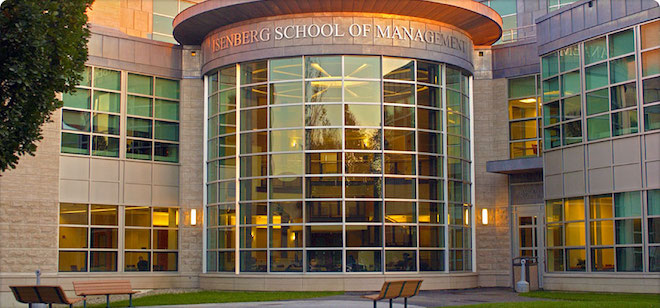
With 1,289 enrollees, the University of Massachusetts-Amherst’s Isenberg School of Management is the most popular of U.S. News’ top 100 online MBA programs
The University of Massachusetts-Amherst’s Isenberg School of Management has offered an online MBA since the 2001-2002 school year, making it one of the “early movers in that space,” says John Wells, associate dean for graduate and professional programs. It took a few years to catch on, he says, but between 2004-2005 and 2010-2011 the program saw “dramatic” growth to reach about 1,100 students. In recent years Isenberg has seen a steady 3% to 5% annual growth to reach its current student population, which lies north of 1,300, Wells says — the most of any school in the top 100 of the latest U.S. News rankings of online MBA programs.
“Our long-term strategy is to balance quality with steady growth,” says Wells, who joined Isenberg in 2010. He adds that the program, listed at 1,289 students by U.S. News, has three enrollment periods and no cap, so the more the merrier — but the biggest challenge it faces is that “with more and more online programs being launched, finding qualified faculty is becoming a bigger and bigger challenge.”
The program saw a dip in the early teens, Wells tells Poets&Quants, but has since rebounded thanks to a concerted marketing strategy. “When I came in there was a decision to centralize marketing at the school level, and so it took a little bit of time to shift our gears and get our marketing efforts focused on this program,” Wells says. “We didn’t really leverage the brand of the overarching Isenberg School of Management. Now we do.”
DIVERSITY APLENTY IN GENDER, RACE, NATIONALITY

Isenberg’s John Wells
Isenberg, ranked 12th overall by U.S. News for the second straight year, has the largest population of online students in the magazine’s top 100 and is one of only two schools with more 1,000; No. 4 University of North Carolina’s Kenan-Flagler School of Business, with 1,047, is the other. Other schools with significantly sized cohorts are No. 100 Embry-Riddle Aeronautical University (946), No. 42 (tied) Northeastern University’s D’Amore-McKim School of Business (869), No. 86 East Carolina (825), No. 72 Ohio University (824), No. 42 (tied) Florida International (805), and No. 27 Washington State (801). Eight more schools have 400 students or more.
(In contrast, a dozen schools have fewer than 50 students, with No. 33 Columbus State University reporting the fewest: 17.)
Of course, student populations are (usually) a diverse group. Wading a bit deeper into the makeup of those student populations, we find quite a few standout facts and figures. Female students, for example, comprise the majority at 10 of the top 103 schools (because of ties, more than 100 schools are officially ranked by U.S. News between 1 and 100), led by a remarkable 60.6% female population at No. 100 Longwood University of Farmville, Virginia. The other schools with more women than men enrolled are No. 36 Hofstra Zarb (51.1%), No. 42 Florida International (50.3%), three Nos. 65: Portland State (53.8%), University of Cincinnati (51.6%), and University of West Georgia (51.2%), as well as No. 82 DeSales University (52.2%), No. 86 (tie) Campbellsville University (58.5%), No. 86 (tie) Texas Southern University’s Jones School (53.2%), and No. 100 Fort Hays State (53.4%). A handful of other schools nearly reach the 50-50 line, including No. 47 University of Colorado-Colorado Springs (47.5%), No. 72 University of Tennessee-Chattanooga (48.3%), No. 82 Rutgers, the State University of New Jersey-Camden (48.5%), No. 86 Clarion University (48.5%), No. 91 California State University-San Bernardino (49.7%), and California Baptist University (48.7%); another 26 schools have female populations of 40% or more. Conversely, only four schools have fewer than 20% women in their online MBA programs: No. 21 University of Mississippi (14.4%), No. 29 Oklahoma State University (17.6%), No. 59 Southern Utah University (13.2%), and Embry-Riddle (17.7%).
In terms of ethnic diversity, no one can outdo No. 36 University of Tennessee-Martin, which has 80 students — all of them minorities, most (88.8%) black or African-American. Texas Southern’s 77 online students are 99% minority, mostly (96.1%) black or African-American, and Florida International’s 805 students are 78% non-white, mostly Hispanic (54.9%) with a large population of African-Americans (20.1%).
Most schools that provided statistics on their international student population — which was 62 of the schools ranked in the top 100 — reported in the single digits, particularly between 1% and 4%, but there were some outliers. No. 91 Missouri University of Science and Technology, with 95 enrollees, reported that fully 21% of them are based outside the U.S.; No. 2 Carnegie Mellon Tepper School was close behind with 19%. No. 3 Indiana University-Bloomington Kelley School of Business was the only other school in double digits, with 13%.
WHAT THE DOCTOR ORDERED
Isenberg’s online MBA is structured to be part-time, John Wells says, so students have a longer window to complete the degree — five years, rather than the more common three. The school boasts an 83% acceptance rate, and between 87% and 92.5% of students graduate in five years. Far fewer (59%) graduate in the three-year window listed by U.S. News, but that time frame does not give an accurate portrait of Isenberg’s approach, Wells says. For most Isenberg online students, “life happens,” meaning they have professional and family obligations; this is borne out by the school’s higher-than-average average student age, 38. “Students typically take one to two courses each term (i.e., fall and spring) and have the option to take courses in the summer, but many students skip the summer term,” he says.
“So … we aren’t really interested in pushing that number up. Given that the majority of our students have families and work full-time, a four-year completion window is appropriate and realistic for a part-time graduate student — and we think this is in the best interests of our students.”
Cost to get Isenberg’s online MBA is $32,175, or $825 per credit hour, full- or part-time, in-state or out, making it something of a bargain — the fourth-cheapest school among the top 15, and considerably cheaper than such options as fellow No. 12 USC Marshall ($92,702), No. 4 Kenan-Flagler ($104,610), or No. 2 Carnegie Mellon Tepper ($122,880).
But fiscal prudence is hardly the chief reason for Isenberg’s popularity, Wells says. Besides its “sophisticated marketing strategy,” the school has been the beneficiary of overwhelmingly positive word-of-mouth, particularly from medical doctors, who comprise about 24% of the students seeking an online MBA at Isenberg. That’s because the school has a “close relationship” with the American Association of Physician Leaders that helps doctors get an MBA with a focus on medical management.
“The AAPL has classes that are very specific to health care management: health care marketing, health informatics, things like that,” Wells says. “What we do is vet that curriculum, and we provide them with nine graduate-level credits that they can apply to an MBA. So when they come to us and get a core MBA, we take what they learned from their AAPL coursework and we apply a focus of medical management.” Word-of-mouth from the AAPL “is very strong,” Wells adds. “They’re very satisfied and that helps us keep those numbers up.”
‘WHAT YOU KNOW AND WHAT YOU CAN DO’
But its innovative “flex focus” is the likely main source of the Isenberg online MBA’s enduring popularity, Wells says. Along with offering traditional focus areas like health care administration, finance, entrepreneurship, and marketing, the school allows students to lash together electives — with the help of an adviser and the imprimatur of Wells himself — to create a set of courses that will qualify as a focus. “Our faculty are pretty active in understanding what current trends are, what’s emerging,” Wells says, “and they’ll have sustainable business practices or social media strategy or something like that, and so instead of trying to figure out what we call their focus, we allow students to tailor their focus to take advantage of these emerging electives that are coming from our faculty and from our school.”
Isenberg has great traditional focuses, Wells says, “but going with a flex focus, you’re probably getting a more niche-level skill set and expertise that probably fill a more emerging gap in the market.” He mentions analytics. The school now offers such classes as Business Intelligence and Google Analytics, leading some students to compile a “human resources analytics” focus. “‘How do I use analytics to be more effective in helping my employees have a more rewarding job experience?'” Wells says is a question students have asked. “So we’re tailoring it, and no focus looks the same.” It’s vital, too, that the school maintains a roster of top faculty, he says.
Isenberg is focused on keeping students satisfied and keeping them in the fold, and that means helping them get real jobs in real markets that may not even have existed when they began their studies. “The world moves pretty fast,” he says. “At the end of the day, employers are only interested in what you know and what you can do.”
ISENBERG’S STRATEGIC GOALS
The flex focus will be “running a little more heavily” in the next couple of years, Wells says. But the Isenberg online MBA may be in for an even bigger transformation, he says, as the school looks to “blur the line between residential and online” studies.
Online students will continue to have the ability to get their degree entirely online, Wells says, but they will be given access to career services, student clubs, and study-abroad opportunities, among other experiences. “In the past, the online program has been fairly siloed,” he says. “But what we found by surveying our students is, they like more touch points back to campus. So what we’re trying to do is bring them — albeit virtually a lot of times — to take advantage of some of those opportunities.” If a guest speaker is visiting the school, for example, the opportunity to attend the speech will be advertised to online MBA students.
Additionally, “we’ve blended a lot of our electives with our full-time MBA so we hold them in the evenings,” Wells continues. “Last night we had our Google Analytics class that had 12 face-to-face students, but another 40 online students — and of those 40 online students, seven of them came in to participate in the actual class. So that’s the biggest thing we’re going to be doing — really blurring that line between the campus experience and the online experience so that online students will feel more connected to Amherst and feel like they can get involved to whatever degree they want to engage.”





Questions about this article? Email us or leave a comment below.